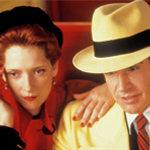 Oh hey, look guys, it’s summertime! And you know what that means: 1) time to sit back and unwind 2) that hardcore dance has gotten a little bit out of control, and 3) there will be a bunch of big special effects type movies coming out. As soon as the sunny days start I get excited for all the greatness and/or crap that’s coming out every Friday, I get nostalgic for the joy I’ve had in movie theaters throughout my life, or even that certain feeling I get from sitting down and waiting for some big expensive heavily advertised movie that will turn out to not be artistically worthy of its Slurpee tie-in. I still cherish the experience.
Oh hey, look guys, it’s summertime! And you know what that means: 1) time to sit back and unwind 2) that hardcore dance has gotten a little bit out of control, and 3) there will be a bunch of big special effects type movies coming out. As soon as the sunny days start I get excited for all the greatness and/or crap that’s coming out every Friday, I get nostalgic for the joy I’ve had in movie theaters throughout my life, or even that certain feeling I get from sitting down and waiting for some big expensive heavily advertised movie that will turn out to not be artistically worthy of its Slurpee tie-in. I still cherish the experience.
And in between watching the new movies I usually do some kind of summer movie retrospective. I’m sort of running out of good anniversaries to do, though, so this year I decided to try a different approach. This will be a series of films that have come out in the past couple decades of summers but didn’t exactly catch on culturally. Some of them will be financial flops or disappointments, others made decent money but were undeniably rejected by audiences. We’ll look at some misunderstood gems, some horrible pieces of garbage, and various stages in between.
 I’m calling them SUMMER FLINGS – things the world flirted with briefly on the screen, then left in the past. Or movies that were flung out there and nobody caught them. Today’s movie is arguably remembered more than most of the others we’ll be looking at, but it definitely didn’t catch the world on fire the way Disney hoped it would, so I didn’t want to skip it.
I’m calling them SUMMER FLINGS – things the world flirted with briefly on the screen, then left in the past. Or movies that were flung out there and nobody caught them. Today’s movie is arguably remembered more than most of the others we’ll be looking at, but it definitely didn’t catch the world on fire the way Disney hoped it would, so I didn’t want to skip it.
P.S. I’m shy about bringing this up, but I’d have a hard time doing a series like this without my benefactors on Patreon, whose generous donations help offset some of the extra days I take off to really dig in and research and what not. So thank you to them and if you enjoy these reviews and can afford it please consider donating (or using any of the other methods of support mentioned on the right side of your monitor/bottom of your phone). Thanks!
* * *
June 15, 1990
When the ’90s began, Tim Burton’s BATMAN seemed like the gold standard for summer movie excitement. In 1989 it had been a phenomenon at the box office, in record stores and at bootleg t-shirt stands, and every studio wanted to find their own Batman.
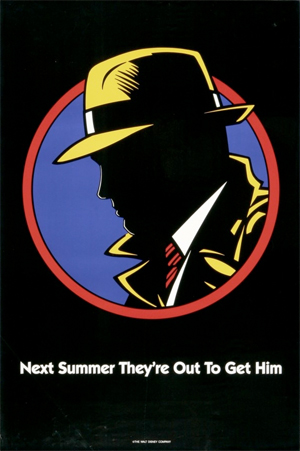 So the next summer, when Disney released director/star Warren Beatty’s DICK TRACY, it had a simple, iconic poster, a thunderous score by Danny Elfman, and a soundtrack album by an iconic pop star (Madonna’s I’m Breathless). Just as Batman had, the DICK TRACY hype reignited interest in an old comic strip, and reruns of a vintage TV show started playing on UHF channels. At the time, David Ansen wrote in Newsweek that after $10 million of advertising, toy and fast food tie-ins and a round of interviews with the usually-reclusive Beatty, tracking showed that “an astonishing 100 percent of the moviegoing public was aware of the existence of this movie before it opened.”
So the next summer, when Disney released director/star Warren Beatty’s DICK TRACY, it had a simple, iconic poster, a thunderous score by Danny Elfman, and a soundtrack album by an iconic pop star (Madonna’s I’m Breathless). Just as Batman had, the DICK TRACY hype reignited interest in an old comic strip, and reruns of a vintage TV show started playing on UHF channels. At the time, David Ansen wrote in Newsweek that after $10 million of advertising, toy and fast food tie-ins and a round of interviews with the usually-reclusive Beatty, tracking showed that “an astonishing 100 percent of the moviegoing public was aware of the existence of this movie before it opened.”
But awareness didn’t necessarily equate acceptance. Like, maybe they’d go see it, but their opening night keepsakes would still end up hanging unwanted next to D.A.R.E. t-shirts in every Goodwill and Value Village in America.
Oh shit, I almost forgot. Before we go any further, everybody put your shirts on.
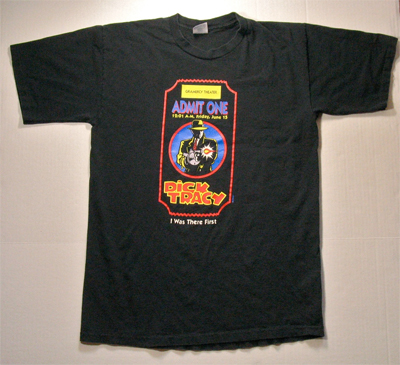
Okay, thanks.
Both BATMAN and DICK TRACY have a big artificial looking city, a money shot of the hero jumping through a skylight to save his kidnapped girlfriend, even a similar joke about him asking someone their weight in order to calculate a heroic stunt and then the person lies about their weight. Both were adapted from comics characters of the 1930s (in this case a comic strip character), so they looked nostalgically at the films of that time period for inspiration. While BATMAN took place in some version of the modern world, it was full of old fashioned movie archetypes: fast talking reporters, gangsters in overcoats and fedoras, weaselly-voiced thugs, steamy alleys.
DICK TRACY takes it further, showing a Prohibition Era city with speakeasies, big cars and tommy gun shootouts. The gimmicky villain deformities of Chester Gould’s comic strip (Flat Top, Pruneface, etc.) are created with elaborate Academy Award winning makeup effects by John Caglione Jr. (C.H.U.D., THE DARK KNIGHT) and Doug Drexler (MANHUNTER), and remarkably the sets and costumes are limited to the seven colors available in Sunday newspaper comic strip printing. It can’t be understated what a unique look Beatty, cinematographer Vittorio Storaro (THE BIRD WITH THE CRYSTAL PLUMAGE, APOCALYPSE NOW, TUCKER: THE MAN AND HIS DREAM) and production designer Richard Sylbert (THE CONNECTION, BREATHLESS, UNDER THE CHERRY MOON) came up with. Tracy has his yellow trenchcoat and hat, the streets are often green or red (with light, not blood), the same shades as the cars, the suits, the bricks, the wrenches, the tables.
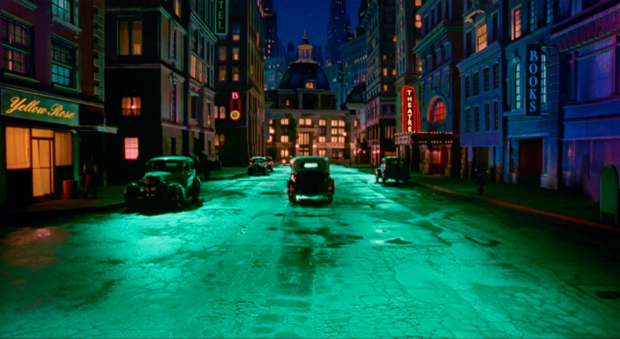

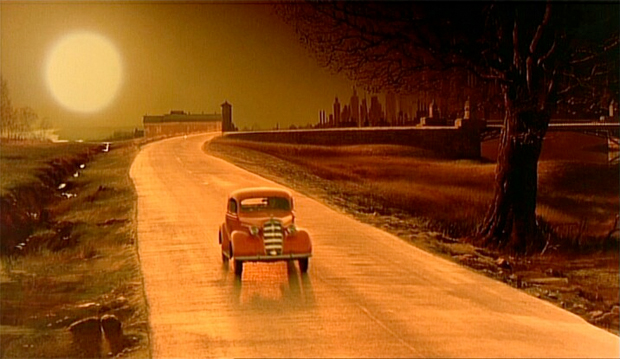
Any time we see a cityscape it reminds me of MARY POPPINS, a live action movie incorporating what looks like animation background paintings. If there’s another ’90s movie that uses this many gorgeous matte paintings I have no idea what it would be.
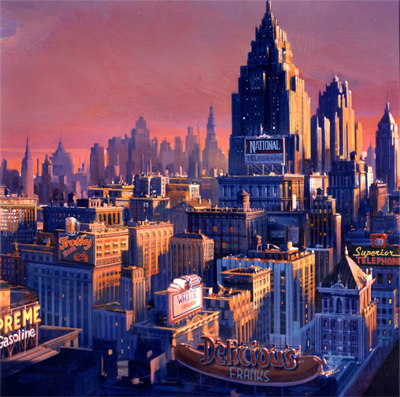
And let’s take a moment to praise the bizarre makeup transformations of two great action movie antagonists. William Forsythe was sculpted into Disney’s Flat Top one year before he was the depraved villains of OUT FOR JUSTICE and STONE COLD. And the haunting eyes of ABOVE THE LAW’s Henry Silva are unmistakable even sunken behind the bizarre face of Influence.
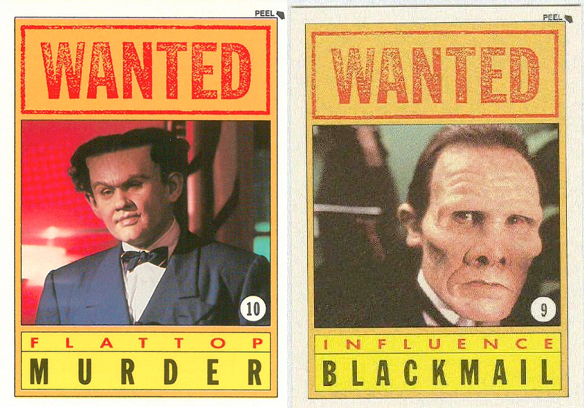
It seems to have about as many montages as ROCKY IV, often intercut with Madonna’s musical performances and zipping through a bunch of time as untouchable Tracy (everybody calls him Tracy, never just Dick) does a series of busts or something. It’s a storytelling shortcut – covering a bunch of ground with a quick series of shots, kinda like telling a story in four panels a day – but it also gives the movie an energetic pace. Hats off to Richard Marks, who only did SERPICO, THE GODFATHER PART II and APOCALYPSE NOW to pad his resume for a gig like this. In my opinion.
The plot (screenplay by TOP GUN/TURNER & HOOCH/ANACONDA/THE FLINTSTONES IN VIVA ROCK VEGAS writers Jim Cash & Jack Epps Jr.) involves mob boss Big Boy Caprice (Al Pacino, SCARFACE) making a move to take over organized crime in the city by turning his mentor Lips Manlis (Paul Sorvino, KNOCK OFF) into a concrete block and taking over his speakeasy, Club Ritz. Tracy is trying to bring down Big Boy’s empire, and a mysterious faceless gangster (referred to as “No Face” in the movie but also called “The Blank”) is up to something in the shadows.
Beatty’s suave heroism conveys period reverence for whichever cop made the most headlines – a paradigm from before DIRTY HARRY. But in truth his law enforcement seems a little petty, being based mostly on storming into clubs hoping to find gambling. Ruining everybody’s night trying to catch somebody on a technicality. It’s kinda like Steven Seagal: Lawman, trolling around trying to catch somebody with a little pot on them and fuck up their life. Except we’ve seen Big Boy murder and kidnap so we know this is for a good cause.
Honestly more compelling than the crimebusting is Tracy’s relationship with his long-suffering girlfriend Tess Trueheart (Glenn Headly, BABE: PIG IN THE CITY), while they try to take care of a little boy named The Kid (Charlie Korsmo, HOOK) who doesn’t want to go to an orphanage after Tracy rescues him from an abusive father. Tracy is real bad about attending to his love life in between chasing after bank robbers and secret warehouse rendezvous. When he tries to turn Club Ritz singer Breathless Mahoney (Madonna) into an informant she comes on to him. Then every time he sees her he stands there with a look kinda like The Dude in THE BIG LEBOWSKI when Bunny offers him a blowjob.
Along with a surface style to rival what any young hotshot could’ve accomplished, Beatty brought his life experience to the character. BATMAN was only Burton’s third feature. He was 31 when it came out, and he imbued its groundbreaking style a young person’s alienated artist angst. But Beatty made DICK TRACY at 53, after more than three decades in Hollywood, having been nominated for Oscars for acting and writing, and winning one for directing REDS (his only movie of the ’80s besides ISHTAR). His legendarily plentiful romantic relationships had been chronicled in gossip and song, but it wasn’t until two years after DICK TRACY that he married Annette Bening and started having kids. So this cartoony movie is very much about where he actually was in life: widely glorified for an extraordinary career (except ISHTAR/being framed by Big Boy), seeing the appeal of slowing down in the name of commitment and fatherhood, but too chicken shit to pull the trigger.
He declares his loyalty to Tess and he never fucks Breathless, despite many offers. But his inattentiveness to his woman combined with constant visible temptation is frustrating in a very authentic way. In the middle of this larger-even-than-your-average-larger-than-life world, Beatty still plays the emotions very real. That grounded, grown up humanity might’ve hurt the movie’s popularity with the young demographic it was aimed at, but it’s definitely contributed to me watching it several times over the years and enjoying it more and more.
I completely forgot that Pacino got a supporting actor Oscar nomination, but I get it. He’s a funny villain, a guy who’s basically Al Capone but trying to be a sophisticate. That he murders a guy to steal his club, then mostly focuses on improving the musical performances, gives him an endearing goofball quality. He frequently misquotes Plato or Nietschze and exhaustedly lectures his henchmen about their work ethic after they fail to kill Dick Tracy.
Breathless is mostly a standard femme fatale, and she’s pretty much powerless in the face of Tracy’s older man charms. But I find something appealing about her unstated need for more control as an artist and as a woman. Big Boy explicitly refers to her as his property, in addition to rehearsing the performers past 2 am. His strive for excellence is kinda admirable, but these are professionals, they know what the fuck they’re doing, who is he to come in here and pretend to be fuckin Phil Spector?
(I honestly wrote that without even considering that Pacino later played Phil Spector.)
So the way Breathless tries to change her situation (SPOILER: she’s The Blank) makes her pretty sympathetic. And the bittersweet ending – Tracy compliments her for almost pulling it off, and she kisses him before dying – is more emotionally complex than the movie’s color palette would imply. When he leaves into the arms of Tess she seems to have less than the full devotion she deserves, allowing the hero to retain the very human weaknesses of the artist.
* * *
Though DICK TRACY opened well (against GREMLINS 2: THE NEW BATCH), Disney specifically wanted BATMAN numbers, and it made less than half as much. It didn’t even end up in the top 10 grossing movies of its year. The summer was dominated by GHOST, TOTAL RECALL, BACK TO THE FUTURE III, DIE HARD 2 and PRESUMED INNOCENT. Other interesting movies playing at that time included THE ADVENTURES OF FORD FAIRLANE, DARKMAN and THE WITCHES.
Now that I’ve spent this entire review talking about DICK TRACY as a response to BATMAN, it’s time to confess that Beatty had bought the rights in 1985 and had been trying to play the character since 1975 (the year of SHAMPOO). According to that Newsweek article Clint Eastwood wanted the role too, and the project went through various directors including Floyd Mutrux (ALOHA, BOBBIE AND ROSE), Martin Scorsese, John Landis and Richard Benjamin. Walter Hill came closest to getting it made, but “wanted to go a realistic, gritty route,” which clashed with Beatty’s vision, as we can see here. Would’ve been interesting to see what that would’ve been, though.
I suspect it incubated exactly long enough to make a good movie, but too long to make a huge hit. I’ve frequently written about how these movies based on pulp, comic strip and radio show characters of the ’30s and ’40s – THE SHADOW, THE PHANTOM, THE SPIRIT, GREEN HORNET, THE LONE RANGER – are almost never successful at the box office. Chronologically and in spirit I guess this is closer to SUPERMAN, POPEYE, ANNIE and BRENDA STARR, most of which did well. But as we get further away from those decades we have fewer and fewer moviegoers who were raised on the entertainment of that era, and less nostalgia for it.
Of course, Lucas and Spielberg had had great success selling youngsters on non-specific nostalgia, as had Disney with WHO FRAMED ROGER RABBIT. DICK TRACY was even paired with a new Roger Rabbit cartoon (a throwback to ’40s cartoon shorts spun off from a throwback to ’40s detective fiction). But Beatty was a guy who grew up on the Dick Tracy comics talking to people who grew up on The Far Side. Maybe it was too tough of a sell.
Or could it be that the action figures were the culprit? I mean, look at this shit. What the hell were they trying to do to kids giving them these hideous fucking things? A brilliant team of artists ingeniously turned Chester Gould’s drawings into costumes and makeup, then this toy company says “I like it, but can we squoosh them into the shape of Ninja Turtles?”
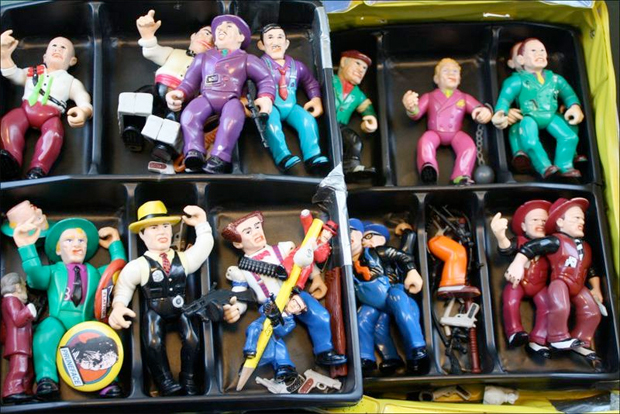
I mean, whatever happened to respect? Whatever happened to dignity? Whatever happened to vaguely accurate anatomical proportions?
Here’s something you may not be aware of: Ice-T did an official tie-in song for this movie. I don’t think anybody knows about it but somehow I did at the time and bought a 12″ of it.
This reminds me: decades later in the timeline of this movie, all rappers would own a copy of BIG BOY CAPRICE in their DVD collections.
But in this timeline, I’m not sure how many own DICK TRACY. It’s not a character too many people give a shit about. Even me – I’m more a fan of Beatty using it as a vehicle for personal expression. Maybe the movie’s biggest legacy is as an obvious inspiration for the R-rated SIN CITY movies. But comparing them is a good way to illustrate the superiority of sets and matte paintings over low budget green screen techniques.
It was still profitable enough that a sequel was considered, but prevented by a legal fight over the rights. That was finally cleared up in 2013, and as recently as 2016 Beatty claimed to be serious about doing a sequel. I suspect the closest we’ll ever get is the novels by Max Allan Collins, who wrote the comic strip for many years and got to do the novelization and two (way out of print) sequel books.
Oh yeah – or the special he made 18 years later where Leonard Maltin interviews him in character as Dick Tracy. Why not?




























May 30th, 2017 at 11:26 am
Oh man the SHIRTS. I have a picture somewhere of myself at like 11 years old and my three younger brothers all wearing different Dick Tracy shirts. What a summer!